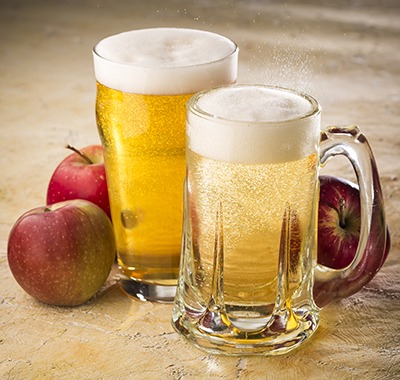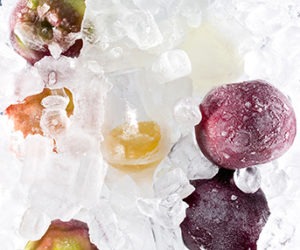Make Your Own Cider

The word “cider” comes to English, like so many food and beverage words, from medieval French. “Sidre” came from Latin, which came from Greek, which apparently came from the Hebrew “chekar,” meaning “strong drink.” So perhaps the English term cider should only apply to fermented or “hard” cider.
Today, outside the United States “cider” generally means hard cider. But even there we find a number of distinct style variations, depending on which country we find ourselves inhabiting. In my experience, and I’m sure I’m making a generalization to which someone will object, I have found British cider to be strong and still, basically an apple wine of 8 percent to 10 percent alcohol by volume, with a very strong apple aroma and fruity flavor.
French “cidre,” on the other hand, is lighter, sometimes sweeter and sometimes quite dry but almost always effervescent. Méthode champenoise bottling procedures (fermenting in the bottle) are used, especially in Normandy and Brittany, France’s most renowned cider-producing regions (and arguably the best in all Europe). Norman hard cider is distilled and aged to produce the wonderful apple brandy known as Calvados.
English cider apples are in all likelihood descended from Norman apples brought over by William the Conqueror in the 1060s. Those same apples, and those of Brittany as well, were also brought to the New World by French explorers and settlers in Quebec. Indeed the province of Quebec is another major producer of hard cider today, most of it similar to the French style, light and sparkling but varying in dryness from sweet and fruity to champagne-like “sec.”
I limit myself to these three influences mainly because that’s where my cider-making picks up. The cider I make is marked by both the English and French traditions. New England farmers tended to make English-style cider (and still do, in the main), fortifying it with various sugars, honey, maple, and the like, letting it ferment on its own naturally (with the possible addition of raisins to inoculate the juice or “must” with a suitable “wild” yeast), and leaving it to age in casks. If it is packaged, it is usually still or only slightly carbonated. In northern New England, where we are closer to Quebec, there is some cross-border influence, and many cider makers in Vermont, Maine, and New Hampshire leave their cider sweeter, fruitier, and lighter, and bottle condition it with added priming sugar.
Cider is one of the reasons I became a homebrewer in the first place. My first foray into homebrewing involved gallon jugs of orchard-fresh sweet cider that I hid in the back of my closet and allowed to turn a little when I was a teenager. But it was my brother Kirk, who began making cider as part of his job as a historian/interpreter at a famous New England farm museum, who really got me going. Tasting some of Kirk’s homemade cider made me long for Normandy (where I had lived for a year) but also reminded me that it was possible to make it myself. I hadn’t yet started making beer either, but Kirk remedied that by buying me a homebrew kit the following Christmas, and the rest is history.
Decisions, Decisions
There are two questions that any would-be cider maker needs to consider, above and beyond all else: How fresh does the cider that you will ferment need to be? And how hard do you want to make it?
The first question simply underscores the choice that you have between buying pressed cider from an orchard or pressing it yourself. It’s convenient, of course, to go to the orchard and buy jugs of fresh sweet cider. There are three considerations, however: price (in peak season, a gallon of fresh cider can fetch as much as $5); preservatives (normally, orchard-fresh cider is untreated, but one must be careful); and suitability for fermentation. This last consideration is the most crucial, and I will come back to it. The other alternative, obviously, is to grind and press your own. This too can be prohibitively expensive.
To press your own you can buy your own grinder and press (which can easily run $450 or more); get friendly with someone who has one (this may cost you in bartered bottles of finished product, or labor); or if you’re somewhat masochistic, you can wash, cut, and grind your apples with a food processor and/or juicer (if you’ve got loads of time and patience).
Some orchards will “custom press” for you — you bring or buy the apples and then use their press on site, usually for a small fee.
If you don’t want to go to the trouble of pressing your own apples, you can buy packaged cider concentrate. Two or three of the malting companies that produce canned beer kits also package cider concentrate kits.
How Hard is Hard?
How hard you want your cider may depend on which style you prefer. To my mind, still ciders can stand to be stronger than effervescent ciders, but that is not a rule. If you want a lighter, sweeter cider, use nothing but apples. If you want something stronger, you will need to add fermentables. Cane and corn sugar are cheap, but honey and maple syrup give more body and more flavor. Add sugars to adjust your starting gravity as you would for beer. Remember that the fermentables in apple juice, maple syrup, and honey are more complex than those in cane or corn sugar, so plan your fermentation schedule accordingly.
What’s In an Apple?
Now back to the question of suitability for fermentation. Not all apples are created equal, and therefore not all apples will make equally good cider. Some are too sweet, some too tart, some too bland. Wise cider makers will blend a carefully selected variety of apples to achieve the flavor they like. The bland apples often serve as a base. They provide plenty of juice and plenty of fermentables but will not have a pronounced effect on the flavor. Tart apples are necessary to balance the sweetness of other sugars, if used, and sweet apples can compensate for the acidity of the base apple. See “Mixing Apples with Apples” (page 28) for ideas on varieties and blends.
Adjunct sugars also depend on your goal. If you want sweeter and more full-bodied cider, use honey and don’t let it ferment all the way out. If you want dry cider, use cane or corn sugar. You can even make a “dark” cider by adding brown sugar or molasses. I often use maple syrup for a real New England touch.
Now, if you talk to New England cider makers, you will hear almost all of them say that there’s enough of the right kind of wild yeast in the apples to get fermentation going. And they’re probably right. After all, we didn’t pitch any yeast in those plastic jugs in the closet, did we? However, there are also acetic acid-producing bacteria in there, so even the best sweet cider will continue beyond hard to vinegar if left alone. For this reason I always pitch a wine yeast.
You can add sulfite to the must to reduce bacteria and wild yeast as many winemakers do, but some people have allergic reactions to sulfites, so you might want to avoid using them. Sulfites do, however, represent a reasonable way to pasteurize your cider if you want to be extra certain to ferment cleanly. One or two Campden (potassium meta-bisulphite) tablets per gallon will eliminate any possibility of bacteria or wild yeast.
Be sure to aerate the must, letting it sit for a good 24 hours before pitching the yeast. A champagne yeast is the best choice, especially if you are going to put it up sparkling.
As in winemaking, it is a good idea to use a bit of acid to increase the tartness of the juice. One-quarter to one-half teaspoon of citric acid or winemaker’s acid blend per five gallons will give a pleasant sourness without overdoing it. If adding any honey or maple syrup, you might also find it helpful to add some sort of yeast nutrient or “energizer” to improve the efficiency of the fermentation.
The How-To
Now that we’ve covered ingredients, the process of making cider is relatively easy.
First, we have to get the juice. The apples must be ground to a pulp and then slowly and gently pressed to squeeze all the liquid out of the fibrous flesh. In a press designed for apples, this happens in a wooden tub lined with cheesecloth or some such straining material, which retains all the solid (“pomace”) while allowing the liquid through. The press itself is a screw with a plate on the bottom. The sweet cider is collected in a container, adjunct sugars added if desired, and voilà, we have “must,” ready for fermentation.
As with fermenting beer, cider is best kept airtight and sanitary. Old-time cider makers may have fermented in cheesecloth-covered barrels in the cellar, topping off the working cider daily with fresh stuff. Knowing what I know about yeast and bacteria, I strongly recommend closed fermentation. I use the same equipment for cider that I use for beer: plastic buckets, glass carboys, and airlocks. Generally speaking I will let my cider work for three to four months (this translates to pressing in September or October, bottling in January). While cider usually does improve with more aging, it is harder to get sparkling cider (which I prefer) if the yeast has mostly dropped out. So I sacrifice a little mellowness for a better effervescence.
My four-month-old cider is primed with corn sugar (seven-eighths of a cup for five gallons) and bottled in champagne bottles, usually corked rather than capped. The reusable plastic champagne corks and wires work great. The bottled cider is put away to age and condition for at least six months. Harder and drier ciders sit for a year or more if I can stand waiting, while sweet and fruity ciders just seem a perfect fit for warm summer evenings. And nothing seems to make the work of grinding and pressing a new year’s harvest go easier than a mug of sparkling hard cider.
Mixing Apples with Apples
There are four basic types of cider apples: sweet, acidic, aromatic, and astringent. Sweet apples include Baldwin, Cortland, Delicious, and Rome Beauty. Acidic apples (medium to high acidity) are Northern Spy, Winesap, Greening, and Pippin, among others. MacIntosh and Russet are the best-known aromatic apples, and astringent apples are basically wild and crabapples, without true varietal names.
If all are available, a good blend would typically include about 50 percent sweet, 35 percent acidic, 10 percent aromatic, and 5 percent astringent. Rarely does a cider from a single variety have all the desired characteristics, so blending is
advisable.
Adapted from The Art of Cidermaking, Brewers Publications
Cider Variations
As with beer, different ingredients and approaches to cider making will give different results. Try some of these variations:
• Use maple syrup instead of honey or sugar for a smoky sweetness and lingering aftertaste.
• Add “mulling spices” such as cinnamon, nutmeg, and cloves for a holiday cider treat.
• Blend apples with other fruit juices: pear, peach, rhubarb, cherry, or strawberry. Test small quantities to make sure you like the combination before you commit your apples.
• Apple beer? Sure, why not? See the Recipe Exchange column in the September ’96 BYO for one possibility, but don’t be afraid to simply blend part cider, part beer wort.
• Many home cider makers have techniques for “fortifying” their cider, and although it is illegal to distill, if one were going to make a harder cider, freezing and removing the ice would be my method of choice (sort of like making an eisbock), but since it’s illegal to do that…



